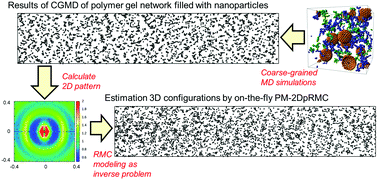Particle-mesh two-dimensional pattern reverse Monte Carlo analysis on filled-gels during uniaxial expansion
Abstract
A particle-mesh-based two-dimensional pattern reverse Monte Carlo (RMC) analysis method (PM-2DpRMC) is proposed for analyzing two-dimensional small-angle-scattering (2D-SAS) patterns. The results of analyzing such patterns in expanded gel networks filled with spherical nano-particles during uniaxial elongation are provided. Previously, characteristic 2D-SAS patterns, such as the two-point bar plate and figure-8 patterns, were observed to possess high stretching ratios in a coarse-grained molecular dynamics (CGMD) simulation, and the patterns were found to depend on the properties of the networks, such as whether they were topologically percolated or not. To establish real-space visualizations of the changes in the particle-configurations corresponding to the 2D-SAS patterns, the on-the-fly PM-2DpRMC method was employed to model the morphology changes of the filler particles during stretching in a series of 2D-SAS patterns. The use of quasi-dynamics to express deformation was validated by evaluating the accuracy of the elongation speed and the number of RMC trials predicted from the behavior of the converged χ2. The results confirm that the obtained sequences of 3D configurations were similar to the original configurations obtained in the CGMD simulations. Further, a demonstrative test using actual experimental data was conducted to verify the completeness of the confirmation.



 Please wait while we load your content...
Please wait while we load your content...